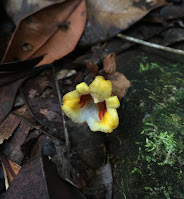 |
| Gastrodia pushparaga Gopallawa, Perera & Madola, in Gopallawa, Perera, Madola, Yakandawala, Kumar, Jayawickrama & Chase, 2023. |
Gastrodia Brown (1810: 330) is a genus of leafless holomycotrophic terrestrial orchids comprising around 94 species (including one natural hybrid) widely distributed from tropical Africa through Japan and the Australasian region (Govaerts et al. 2022). It is characterized by fleshy underground tuber, a smooth or coralloid rhizome, a perianth tube formed by fusion of sepals and petals (connate and cleistogamous to partly open), a gibbous perianth tube under the labellum instead of a spur and sectile pollinia without caudicle (Seidenfaden & Wood 1992, Pridgeon et al. 2006, Kumar et al. 2020).
In Sri Lanka, this genus is represented by only two species, G. zeylanica Schlechter (1906: 77) and G. gunatillekeorum Bandara, Priyankara & Kumar in Bandara et al. (2020: 436). During a recent survey in April, 2021, in the Walankanda Forest Reserve, Rathnapura District, multiple specimens of an unusual Gastrodia species were collected. Later, two more populations were recorded from the Rathnapura District, one from Walankanda and another from Kalawana. Exactly a year after this, the new species was discovered at another three sites from February–April, 2022 during a study on fragmented forest sites in the adjacent Sinharaja Man and Biosphere Reserve reserve within the same district. A critical analysis of the plants revealed their morphological similarity to a Taiwanese endemic, G. sui Leou, Tsu & Yeh in Yeh et al. (2011: 417) and the more broadly distributed G. uraiensis Hsu & Kuo (2010: 244), but these two species can be differentiated easily from these recently discovered plants, and, therefore, the Sri Lankan plants are described here as a new species. Individuals with both flowers and fruits (for dry and spirit collections) were collected to aid in taxonomic identification. Voucher specimens (both dried and spirit collections) have been deposited at PDA.
Gastrodia pushparaga Gopallawa, Perera & Madola, sp. nov.
Etymology:—Referring to the yellow sapphire, locally known as pushparaga, in the Rathnapura district, famous for its gems. The flower colour is similar to that of yellow sapphire, where a high-quality yellow sapphire has a red tint, similar to the flower. This epithet is to be treated as a noun in apposition.
Bhathiya Gopallawa, Amila Perera, Indrakheela Madola, Deepthi Yakandawala, Pankaj Kumar, Harsha Jayawickrama and Mark Chase. 2023. Gastrodia pushparaga (Orchidaceae, Epidendroideae, Gastrodieae), A New Species from Sri Lanka. Phytotaxa. 587(2); 193-199. DOI: 10.11646/phytotaxa.587.2.8











